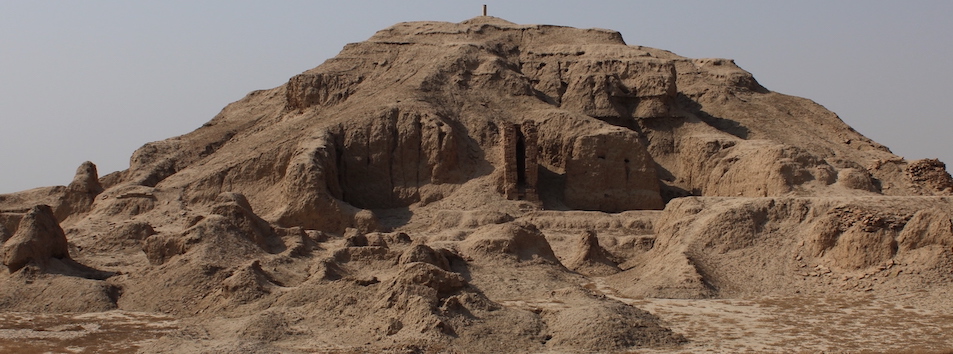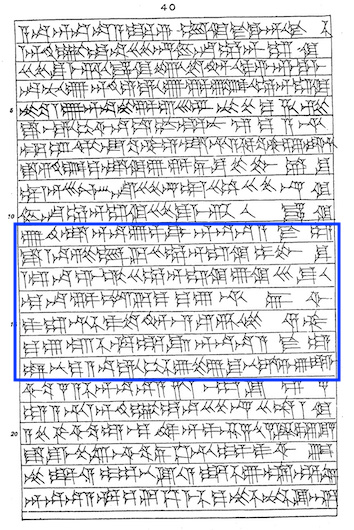Ehiliana (cella of Nanāya in Eanna at Uruk)

The goddess Nanāya, a deity closely associated with Inanna/Ištar, had a cella in Eanna, which went by the name Ehiliana. In the late Neo-Assyrian period, during the reigns of Esarhaddon (r. 680–669 BC) and his son Ashurbanipal (r. 668–ca. 631 BC), this holy part of Eanna received special attention, principally since Nanāya was then second-most important deity at Uruk.
Names and Spellings
This Sumerian ceremonial name of this part of Eanna is called Ehiliana, which means "House of the Luxuriance of Heaven."
- Written Forms: e₂-hi-li-an-na.
Emeurur ("House that Gathers the Mes") was the name of Nanāya's temple at Uruk during the Old Babylonian Period. Based solely on the building history of Nanāya's cella given in an Akkadian inscription of Esarhaddon, it is possible that Ehiliana was used to designate the holiest room of this goddess at Uruk in (or before) the reign of the Kassite king Nazi-Maruttaš (r. 1307–1282 BC). Contemporary evidence, however, is lacking.

Plan of Uruk showing the locations of Eanna (with its ziggurat), the Rēš Temple, and Eʾešgal. Drawn by Ardeth Anderson for the Lagash Archaeological Project (LAP).
Known Builders
- Middle Babylonian (ca. 1600–1000 BC)
- Nazi-Maruttaš (r. 1307–1282 BC)
- Early Neo-Babylonian (ca. 1000–710 BC)
- Erība-Marduk (reign ended before 760 BC)
- Neo-Assyrian (ca. 911–612 BC)
- Esarhaddon (r. 680–669 BC)
- Ashurbanipal (r. 668–ca. 631 BC)
Building History
A cult of the goddess Nanāya is attested at Uruk as early as the Ur III Period (ca. 2112–2004 BC) and as late as the Seleucid Period (ca. 305–64 BC). In the Old Babylonian Period, the name of Nanāya's place of worship was Emeurur, which is mentioned by name in a Sumerian inscription of Sîn-gāmil (r. 19th century BC), an Early Old Babylonian ruler of Uruk who had that temple (re)built. Sîn-gāmil's third successor Anam (r. 19th century BC) also claims to have renovated Nanāya's place of worship at Uruk, probably in connection with his work on the Eanna precinct. After the abandonment of Uruk during the reign of Samsu-iluna (r. 1749–1712 BC) — the son and immediate successor of Hammu-rāpi (r. 1792–1750 BC) and seventh ruler of the First Dynasty of Babylon — the cult of Nanāya (together with those of Inanna/Ištar and An/Anu), briefly migrated to Kish. Shortly thereafter, if inscriptions of the Neo-Assyrian king Ashurbanipal are to be believed, Nanāya's cult image was carried off to the Elamite religious capital Susa; the Elamite ruler Kudur-Nanhundu (Kutir-Nahhunte I), a contemporary of the Old Babylonian kings Samsu-iluna and his successor Abī-ešuh (r. 1711–1684), is named as Nanāya's abductor.
According to an Akkadian inscription of the Neo-Assyrian king Esarhaddon, the Kassite king Nazi-Maruttaš (re)built or renovated Ehiliana. If this reflects historical reality, then Nanāya's cult at Uruk, despite the abduction of its cult image several hundreds of years earlier, had been restored in or before this time. Clearly, a new cult statue had been created and was worshipped in her cella. No details are known given the complete lack of contemporary sources and the brevity of the building report in which Nazi-Maruttaš is named as one of the rulers who had worked on Ehiliana.
Esarhaddon also names Erība-Marduk, a member of the Bīt-Yakīn tribe in the Sealand who became the king of Babylon, as a previous builder of Ehiliana. Although no details about this project are recorded in extant cuneiform sources, Erība-Marduk's work on the Eanna complex was not favorably remembered. Neo-Babylonian royal inscriptions and the so-called "Uruk Prophecy" state that he replaced the existing statue of the goddess Ištar with a new and less-appropriate one. It is not known if he did the same with Nanāya's.

In 693 BC, the troops of Sennacherib (r. 704–681 BC), Esarhaddon's father and immediate predecessor, entered Uruk and took its gods back to Assyria, where they remained in captivity until Esarhaddon became king. Esarhaddon not only returned the cult image of Nanāya (as well as those of Ištar and Uṣur-amassa), but he also renovated her cella (Akkadian bīt papāhi) Ehiliana. One Akkadian inscription of his written on a clay cylinder records the following:
As he did with Ištar in Enirgalana, this text records that the king had the statue/image of the temple's patron deity returned to its dais. In addition, a second inscription (also written in Akkadian) records that this Assyrian king made an elaborately-decorated doorbolt (Akkadian šigaru) for Ehiliana. Esarhaddon presumably decorated the rest of the interior of Nanāya's cella with objects made from and plated with various types of metal.
In 646 BC, the armies of Ashurbanipal, Esarhaddon's son and immediate successor as king of Assyria, thoroughly looted and destroyed the important Elamite religious center Susa, including its most important temples and its ziggurat. Akkadian inscriptions of his record the treasures that this Assyrian king's troops had discovered in that city's palaces and sacred buildings, which included royal and divine objects that had been looted from Babylonia by Elamite kings (on seven different occasions) or that had been sent there as bribes by former kings of Babylon, including his own brother Šamaš-šumu-ukin. Of the numerous items kept in Susa's treasuries, the most important, at least according to the textual record, was a statue of Nanāya, which Ashurbanipal believed had been carried off to Elam "1635 years" earlier. That statue, was ceremoniously returned in late 646 BC to its "rightful" place in Uruk. Ashurbanipal appears to have sponsored work on Ehiliana, but since none of the texts of this king (thought to be) written for objects deposited or displayed are sufficiently preserved, it is unclear what that Assyrian king did for Nanāya's cella at Uruk after he had her "long-lost" cult statue returned. Because an image/statue of Nanāya was already in Ehiliana at the time, it is not known if Ashurbanipal replaced the then-residing Nanāya statue with the one he had taken from Susa or if that long-absent image was placed elsewhere in the Eanna complex. How this dilemma was resolved is not recorded in presently-available sources. It is certain, however, that Nabopolassar (r. 625–605 BC), the founder of the Neo-Babylonian Empire (625–539 BC), returned the Nanāya image that Ashurbanipal brought into Ehiliana in 646 BC to Susa in 626 BC. It is unclear, however, if that Neo-Babylonian king sponsored any work on Nanāya's cella.
Archaeological Remains
Ehiliana has not yet been positively identified in the archaeological record.
Further Reading
- Beaulieu, P.-A. 2003. The Pantheon of Uruk during the Neo-Babylonian Period (Cuneiform Monographs 23), Leiden and Boston, pp. 29–33 and 182–189.
- George, A.R. 1993. House Most High: The Temples of Ancient Mesopotamia (Mesopotamian Civilizations 5), Winona Lake, p. 98–99 no. 459.
- Stol, M. 1998. "Nanaja," Reallexikon der Assyriologie und vorderasiatische Archäologie 9/1–2, pp. 148–150.
Banner image: view of the Eanna ziggurat from the east (September 27th 2019). Photograph credit: Mary Frazer.
Jamie Novotny
Jamie Novotny, 'Ehiliana (cella of Nanāya in Eanna at Uruk)', Babylonian Temples and Monumental Architecture online (BTMAo), The BTMAo Project, a sub-project of MOCCI, [http://oracc.org/btmao/Uruk/Eanna/Ehiliana/]